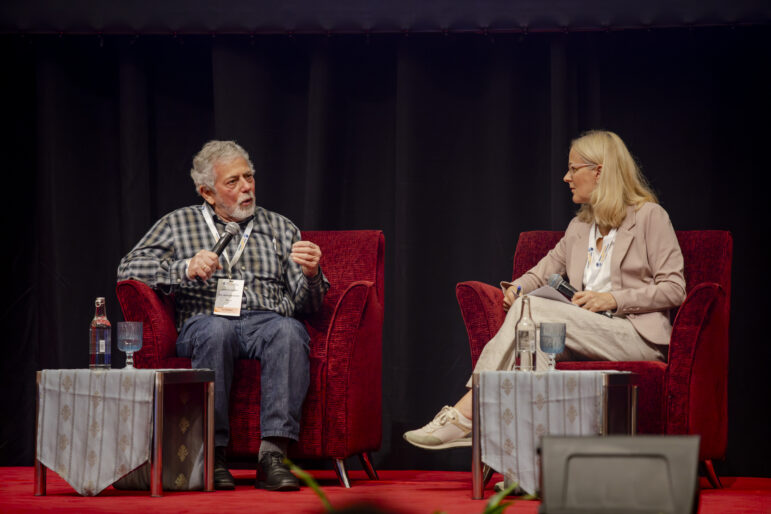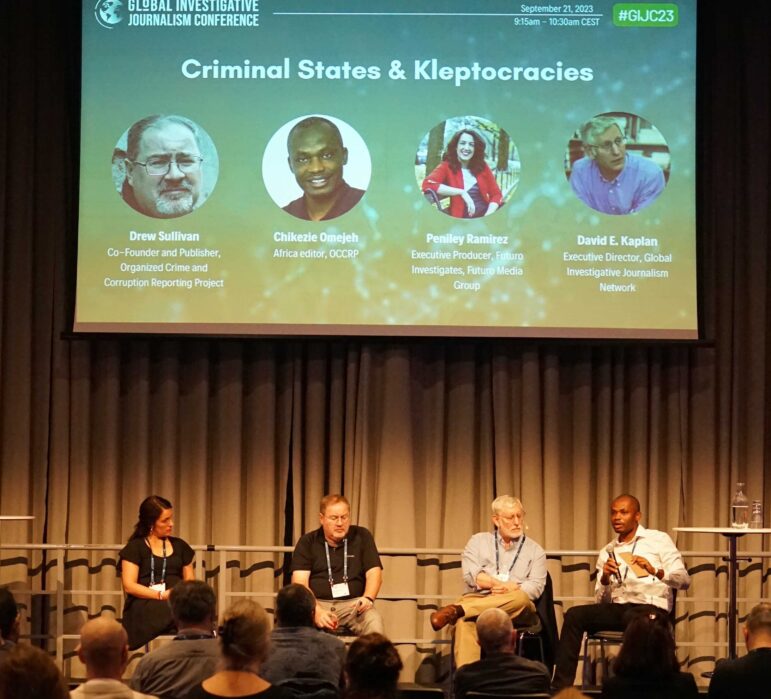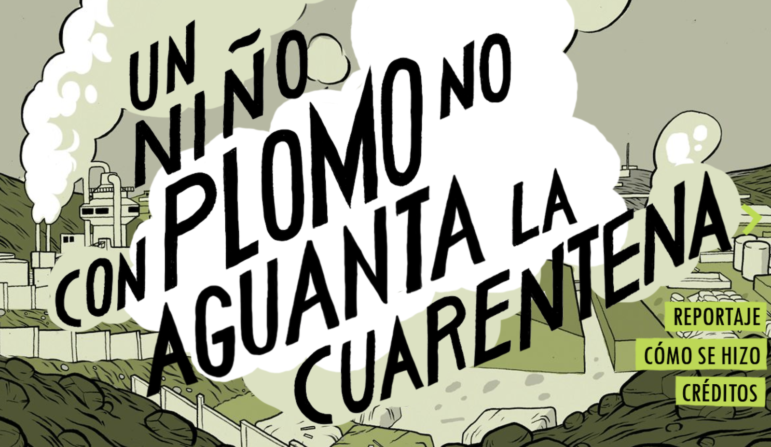

Gustavo Gorriti (left) speaks with Finnish investigative reporter Minna Knus-Galán in one of the keynote conversations of GIJC25. Image: Suzanne Lee, Alt Studio for GIJN
It was back in the early 1990’s when men armed with submachine guns whisked the Peruvian journalist Gustavo Gorriti from his house in Lima to a detention center.
As correspondent for the Spanish newspaper El País, Gorriti had delved into the web of corruption encircling the then-President Alberto Fujimori, and his political fixer and spymaster.
After Gorriti was kidnapped by military intelligence agents a contingency plan he had set up was swiftly put in motion by the people he had briefed — starting with his wife, whose crucial actions were key to saving his life. She contacted his editors at El País and international human rights organizations, who conducted a massive pressure campaign on the Peruvian government, which released Gorriti two days later.
In his keynote conversation with Finnish investigative reporter Minna Knus-Galán, “Investigating in the Face of Repression,” during the 14th Global Investigative Journalism Conference (GIJC25), Gorriti talked about finding a balance between staying safe as a journalist and always striving to find and publish information the powerful want to hide.
Thirty years on from that brush with the dark side of the Fujimori regime, Gorriti continues to work to expose corruption, often facing a multitude of attacks for the work he does at IDL-Reporteros, an investigative outlet and GIJN member. In recent years he has been targeted by ferocious disinformation campaigns, faced investigations by the prosecutor’s office, and received a death threat from Lima’s mayor, who appeared to call for Gorriti’s murder.
Gorriti’s version of bravery while reporting is not about rushing towards danger, but instead adopting a methodical risk analysis, the strategy of a survivalist who is prepared to face the perils that come with the job. He calls it being “tactically cautious.”
“And what do you mean by being ‘tactically cautious’?” asked Knus-Galán.
Gorriti explained this approach with practical tips:
- Avoiding the places and situations where you suspect there might be a trap.
- Being aware of the intangible power of journalists and the enormous influence they can have, especially when investigations resonate with the public. It was this power, for example, that enabled his allies to pressure for his release in 1992.
- Tending to your sources and letting them know when those you’re investigating might make a move against you.
- When leading a newsroom, never allowing a reporter to take a risk that you wouldn’t take.
- Being active and vocal in defending your work and your name if either come under attack.
A final tip from Gorriti, a long-time judo practitioner, goes a step further and even suggests learning physical self-defense. When mentioning this, a person in the front row who knows Gorriti chuckled and nodded knowingly.
But staying healthy is key to Gorriti, who recently overcame stage IV cancer. “You want to avoid burnout after working through two sleepless nights?” he questioned the audience. “Sure, you can head to the nearest bar, but you can also decide to go to bed, sleep, and exercise the next day.”

The Centre for Investigative Journalism’s James Harkin asks a question during the session. Image: Suzanne Lee, AltStudio for GIJN
Struggle Against Disinformation
Gorriti reminded his audience that even if you publish the most devastating investigations against wrongdoers, corrupt power structures are incredibly resilient and might eventually hit back.
Besides reporting on Peru’s armed conflict and dictatorship during the 1980’s and 1990’s, more recently, as director of IDL-Reporteros, Gorriti and his team helped to uncover arguably the biggest political scandal in Latin American history: the massive corruption campaign of Odebrecht, a Brazilian infrastructure colossus, that in order to win billions of dollars in government contracts across the region, financed dozens of presidential and parliamentary campaigns, and bribed a slew of high-level officials in 11 Latin American countries.
The work earned him and IDL-Reporteros in 2019 GIJN’s Global Shining Light Award. The revelations led to the indictment of four Peruvian former presidents, one of whom, Alan García, committed suicide when police came for his arrest.
But this dogged reporting into corrupt power structures in Peru eventually caused a backlash against Gorriti. Alongside judicial investigations that press freedom groups have decried as politically motivated, Gorriti has also been a victim of a social media disinformation campaign regarding a cancer diagnosis, physical harassment, and far-right protesters have surrounded and thrown trash at IDL-R’s headquarters.
He noted that attacks on journalists’ revelations and reputations are being used around the world. Investigative reporters need to defend themselves, he argued, particularly when their stories are being targeted by disinformation campaigns, and their reputations tarnished by falsehoods.
“As an investigative journalist you don’t only need to deeply research your stories, and do fact-checking again and again, but also defend your stories when they’re being attacked by disinformation, and at some point this will also mean defend yourself,” he said.
He added that reporters in this situation should go on the offensive, and use their investigative skills to reveal the structures that enable disinformation and the strategy behind it: who is publishing it, where it’s coming from, how a campaign against you has been designed.
He also pointed to the power of collaboration, and suggested reporters create a network of organizations that can work together to uncover disinformation, or find common links and actors.
Finally, Gorriti urged new generations of journalists to strengthen their storytelling skills by reading great works of literature and narrative journalism; not just relying on data mining and digital research skills. “Read!” he stressed. “Read and work out.”









